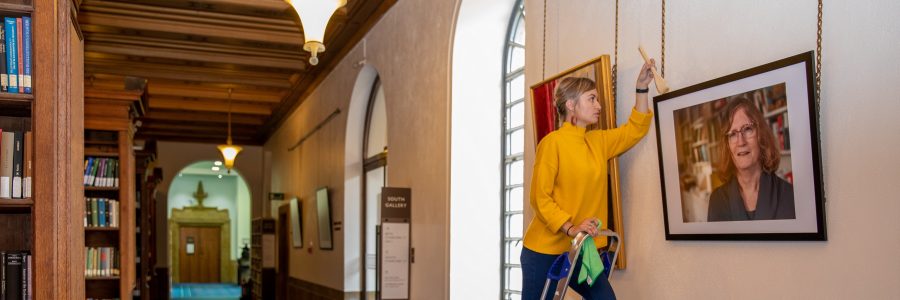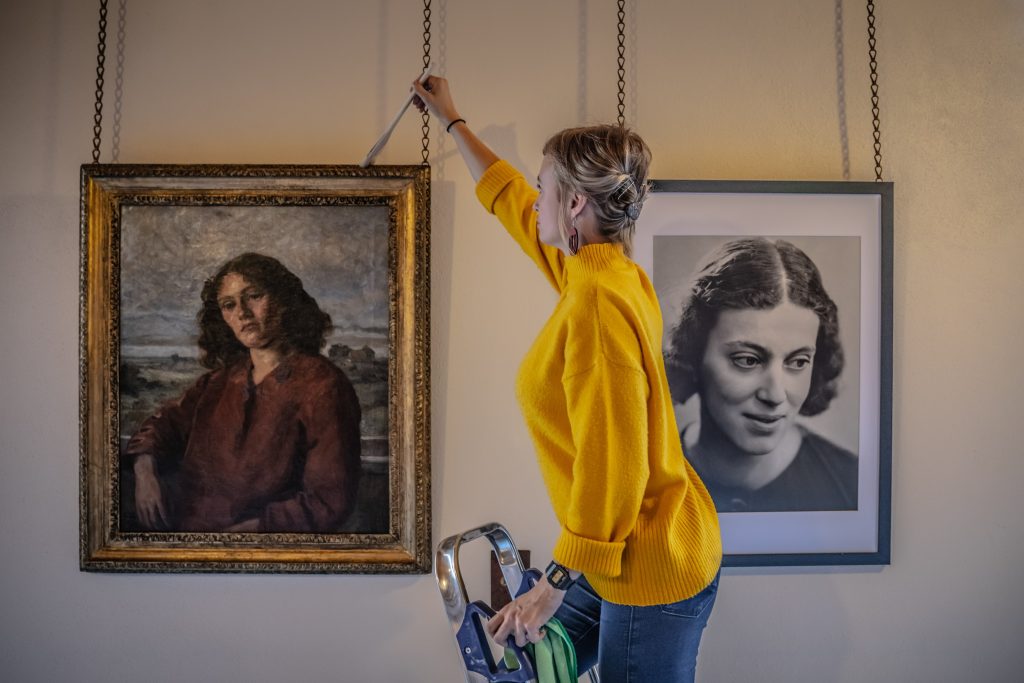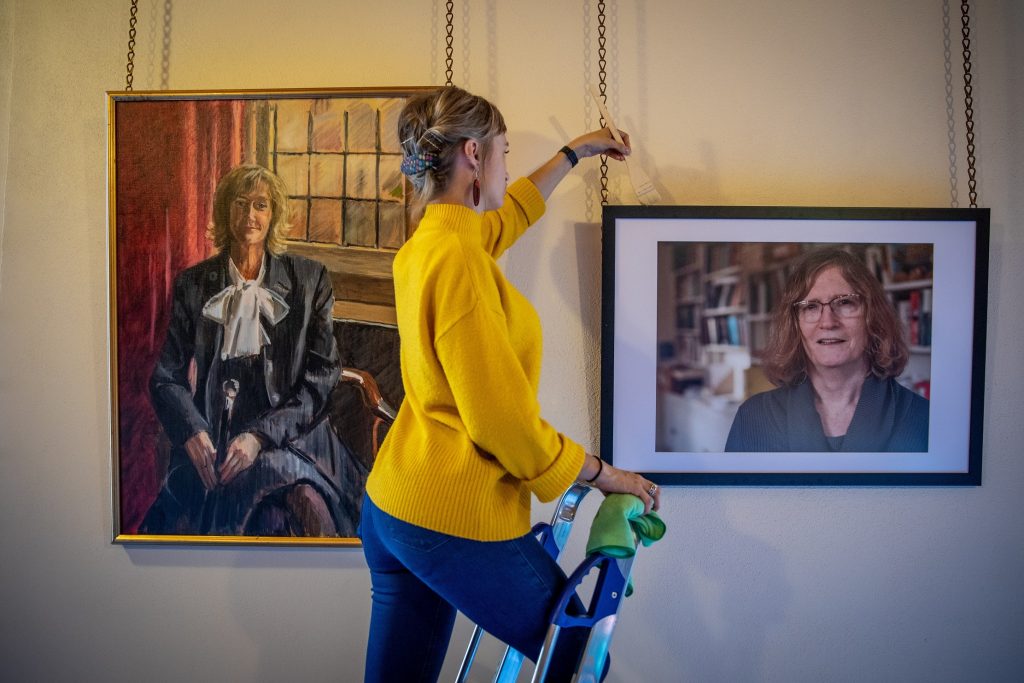
Women at Cambridge portraits exhibition
In October 2019, The Rising Tide: Women at Cambridge opened at the University Library. This consisted of a programme of exhibitions and events focused on women’s roles in the history of Cambridge University, from foundation to the present day. A major exhibition, curated by Dr Lucy Delap and Dr Ben Griffin, was held in the University Library’s Milstein Exhibition Centre. The displays focused on the lived experiences of women at the University, the ongoing fight for equal educational rights, recognition, and inclusion in university activities, and the careers of some of the women who shaped the institution. Through a mix of costume, letters and audio-visual material, the fascinating and little-known stories of individual women were illustrated. To complement the major exhibition, we decided to create a portrait exhibition of inspirational women from Cambridge’s illustrious past. This aspect was co-curated by Public Programming Assistant Holly Pines, and University Librarian Dr Jessica Gardner. The project took almost two years from conception to completion and required vast amounts of research in the University and College archives. Unfortunately, due to COVID-19, the University Library had to close three days before the exhibition end date. However, thanks to Cambridge Assessment, a virtual tour of both exhibitions is now available.
In keeping with The Rising Tide’s intentions of collaboration, we wanted to approach colleges and University departments to be involved with this aspect of the exhibition too. In total, there were twenty-six portraits featured, fifteen of which were loaned from a variety of Cambridge institutions. In some cases where the portraits we wanted to borrow were too fragile, they were photographed, and we exhibited a hi-resolution facsimile.

But firstly, you may be wondering how we came up with our selection. One word: research. It was Holly’s job to create a list of significant women since the University’s founding in 1209. To start she used the University Archives, before moving online and using portrait databases to see if portraits existed of these women. As you can imagine, there were very few portraits of women, especially in comparison to men, and the majority of women who were commemorated were aristocratic. Some of the first women of significance were the founders or benefactors of colleges, such as Lady Margaret Beaufort, Dame Joyce Frankland and Lady Elizabeth de Clare. As Holly moved through the years, towards the establishment of Girton College in 1869, more women became prominent. These included women like Emily Davies, Joan Pernel Strachey and Marion Kennedy, who were involved in the creation of the new women’s colleges, and often had already created a name for themselves within the sphere of the women’s rights movement. Amazing stories of women coming first in their year groups, women who formed the Girton Fire Brigade and women who had to do their exams separately in the houses of academics made the research process particularly rewarding. However, it was still inescapably clear how few women were celebrated in comparison to their male counterparts.
The team at the main UL had decided to use the North and South front galleries to hang the portraits, as space usually only accessible to readers. In 2018 the exhibition Black Cantabs: History Makers curated by the Black Cantabs Research Society was hung down in this space, the first time the space had been used in this way. We wanted to repeat this for The Rising Tide. Before the Black Cantabs exhibition, most of the portraits that adorned the walls were of eminent male Victorians. These formal portraits of long-dead men looked suitably grand, but did not reflect the diversity of today’s UL users. Nor did we want our new exhibition to just include formal oil paintings. We decided to intersperse newer, less traditional portraits among them.

The initial list of potential portraits of women to include in the exhibition ran to thirty-two pages. This document was whittled down to roughly forty women, with Jess, Holly and Dr Chris Burgess (the Exhibition Manager) meeting regularly to hone the selection. It was important to include women of varying ages, colleges and departments, historical eras, disciplines and backgrounds. At points this seemed difficult; Cambridge’s history until recently lacked diversity. We then made the decision to commission new works, so as to be representative of the modern Cambridge.
The final exhibition consisted of twenty-six portraits. They were borrowed from a plethora of colleges and departments and three portraits were commissioned specifically for the project, two of them being photographs. One of the Gonville and Caius Joyce Frankland Feminist Society, which hangs next to the portrait of Joyce Frankland, a major benefactor of both Emmanuel and Gonville and Caius colleges, and one of current CUSU Women’s Officer Kate Litman. The other was a painting by contemporary artist Caroline Walker of women working in the labs at the Gurdon Institute. Because of this project, the University Library has also purchased an artwork by Leonora Saunders, an interpretation of Dorothy Garrod, the first female Oxbridge Professor, which will remain on display in the building.
Throughout we wanted to ensure a balance between household names and portraits of lesser-known women (although arguably many of the women included should already be household names). As the portraits were being hung, one subject became even more well-known. Baroness Brenda Hale, an alumna of Girton and first female President of the UK Supreme Court, hit the headlines for delivering the verdict that the Prime Minister had acted unlawfully in suspending parliament in the lead-up to the Brexit deadline. Other more prominent women include Rosalind Franklin (whose work on crystallography was central to the understanding of the molecular structures of DNA,) Jocelyn Bell Burnell (the astrophysicist who discovered radio pulsars in 1967) and Dorothy Hodgkin (who won the Nobel Prize for Chemistry in 1964, and is the only British female scientist to have been awarded it). Lesser-known trailblazers included Lettice Ramsey, a photographer who ran a successful studio in the 1930s and photographed the Bloomsbury Group, and Caroline Mary Ridding, who was a Sanskrit and Pali scholar and the second woman to be employed by Cambridge University Library. Having these portraits hang in the corridor of the University Library provides a visual representation of how women have been and continue to be at the centre of Cambridge’s evolution.

I worked in the UL from 1956 -1963. There were lots of young ladies then, working in different departments of the library. But even at that time there were quite a few of the older men who really didn’t think we should be there. Unless we were cleaners or secretaries.
Thank you for this Patricia. How interesting! I’m going to email you if that’s OK. Keen to hear what it was like at the UL then (Liam – Special Collections)